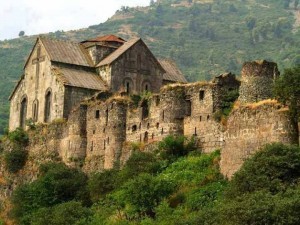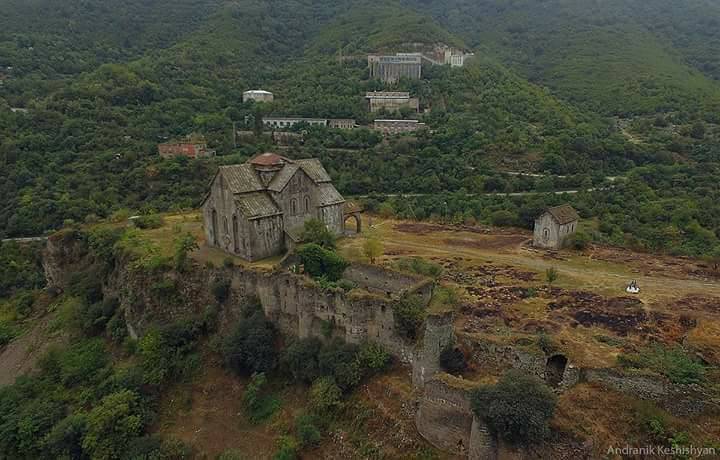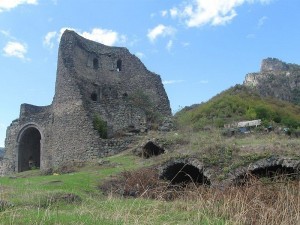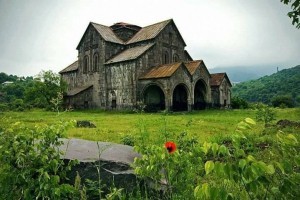Akhtala is a monastic complex that has enclosures around it. The monastery is in Lori province, Akhtala village. The date of the establishment is probably the tenth century. Akhtala monastic complex is 185 km to the north from Yerevan. The monastic complex is a Chalcedonian monastery. Its construction date coincides with the period of Renaissance. Among the group of monuments of Akhtala monastic complex, there are elements of Armenian, Georgian and Byzantine architecture.
Akhtala’s St. Astvatsatsin monastery has been the largest Chalcedonian monastery of the North Armenia. In 12-13th centuries it had a religious, educational and cultural considerable role.
The fence that surrounds the monastery is from the period of Bagratunyans. The walls stretch from north to south along the perimeter of foreland.
The main entrance is from the north. In the thirteenth century Ivane I Zaqaryan made the monastery Chalcedonian priory.
The main church of Akhtala is St Astvatsatsin in the central part of the fortress.
From the east, appendant to the church, there is a hall and a little church that has a rectangular altar.
There is another church in the yard. The monastery has had residential and economical buildings, but only the walls that have two storeys exist now.
Most noteworthy, this is the main sightseeing in the area that attracts tourists mostly. A monastery is also a place for national holidays and entertainment.
In the monastic complex, Sergey Parajanov shot some scenes of ” The colour of the Pomegranate”. Currently is being renovated the dome of the church, as well as, other parts of the church.
The Another Name of the Monastery
In the middle ages, the monastery had a name of Pghindzavank. We learn about this name from “Armenian History” of Kirakos Gandzaketsi. There he mentions the death of prince Ivane Zaqaryan in 1241. His body they buried in Pghindzahank. Ivane had snatched from Armenians and made it Georgian, means Orthodox Church. After the adoption of orthodoxy, Ivane reestablished the church and called it Akhtala. According to Gandzaketsi in the same church is the grave of Ivane’s son Avag.
The History of the Fortress
In 1887-1889 Jacques de Morgan (a French archaeologist) during the excavations discovered 576 tombs that had a rectangular shape. Along with those tombs, he discovered cultural items. From these excavations, he found out that those items made of clay, bronze and iron were from the 8th century near Akhtala.
The date of the establishment of Akhtala monastery’s fortress dates back to the Bronze and Iron age. Kyurikids were the founders of the monastery.
St Astvatsatsin Church
The main church of Akhtala monastery is Holy Mother of God church. It’s situated in the centre of the fortress. It has two domed compositions with eight-sessions struts. The oratory in the east ends with Avag altar. The dome doesn’t exist now. It arose along with the vaults of the strut and altar.
So, there is no information about the exact date of the building. Some archaeologists mention the 11th-3th-century complex, but currently, the information about the date goes back to the earlier times that 11th-13th centuries. Princess Mariam who was the daughter of Gurgen II made a record in 1188 on the back of khachkar which refers to the construction of the Holy Mother of God church at Akhtala. Her inscription was so: “I, the daughter of Kyurikeh, Mariam, erected Surp Astvatsatsin at Pghindzahank, those who honour us remember us in their prayers.”
The Murals of Holy Mother of God Church
The monastery has many embroideries in the inner side. There are many murals of Old and New Bibles on the walls, struts, vaults and altar.
The murals of the major altar of the church are tripartite. So every part of the murals is separate from each other. They have different colours of outlines.
On the upper line is Mother of God. On the second line is Holy Sacrament. In the last scene Christ gives bread to the group of Apostle Petros. In the third line, we can see apostles and saints.
So comparing different sources we see that there are names of 25 different saints and ecclesiastical people in the scene lines of the altar. Muraviov mentioned the fact, that among these saints there isn’t an ecclesiastical priority. This means that it doesn’t correspond to the rule of Ikonostas of the Orthodox Church.
According to Lidov, this kind of mismatch can’t happen because the painter didn’t know his work well, as everyone knows that the painter knew how to make a high art. In the contrary, it was a nice plan to make a mural, including Armenian, Georgian, Byzantine and Roman ecclesiastical in the same place.
Pilgrimages to Akhtala’s Holy Mother of God Church
The 21st of September is the birthday of Mother of God. That day is also the dy of the pilgrimage to Akhtala’s monastery. First pilgrims are coming here from the last day’s evening. The main part of them are Armenians from Georgia and previous inhabitants of Akhtala. The next, main day, usually many pilgrims gather is the yard of the monastery and it’s full of people.












Leave a Comment